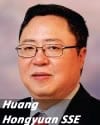The heads of the exchanges that currently operate the Shanghai Hong Kong Stock Connect have given their plans for how the trading link is likely to evolve over the short and medium term. That vision includes the inclusion of Shenzhen listed stocks, equity derivatives, commodities and the development via the link, of an offshore rates business for China.
Huang Hongyuan, president of the Shanghai Stock Exchange (SSE) and Charles Li, chief executive of Hong Kong Exchanges and Clearing (HKEx) gave their thoughts at the Asia Financial Forum, held in Hong Kong.
The Stock Connect has become more heavily used, having started at a slower pace.
“It takes time for something as big and complicated,” said Huang Hongyuan. “Because of different laws and procedures, institutional investors still don’t fully understand A shares, so they took a wait and see approach. Investors are also apprehensive about the temporary nature of certain waivers that applied to the Stock Connect.”
Those waivers included matters such as taxation, that had to be figured out before the start date of the programme.
Northbound trading has outpaced southbound trading by a ratio of 6:1. In the first two months of trading, that ratio was 8:1, but southbound trading has increased this year, and since the beginning of January the ratio has been 3:1.
The number of southbound accounts has risen from 165,000 in November, to 500,000 today, according to Huang. He added that there would be a comprehensive review of the stock connect within six months.
Bringing Shenzhen listed shares into the Stock Connect is the next target, according to HKEx’s Charles Li.
“One leg (Shanghai) is out and the other (Shenzhen) needs to go,” he said. “I’ll be disappointed if it doesn’t happen this year. It will be easier than with Shanghai because it is largely replicating systems. There may be enhancements introduced at that time, which will also be applied to the Shanghai connect.”
After Shenzhen is introduced, Li highlighted commodities, international equities, equity derivatives and an offshore rates business for China as being other angles that he believes a future Stock Connect may embrace, subject to benchmark licensing and liquidity connectivity.
“The Stock Connect quota is history – today we talk about turnover,” said Li.
He was referring to the data that shows that daily trading volume of buys and sells exceeds the usage of the Stock Connect’s aggregate quota, which measures only net buying. Before a month ago, that statistic had been sidelined and a net (buy – sells) quota usage figure was more commonly cited. That gave the false impression that the Stock Connect was hardly being used, which overshadowed media commentary at the time.
From 29 December 2014 to 9 January 2015, the average of northbound and southbound daily trading was RMB5 billion and HK$2 billion respectively.
